A Mini Review on Doped Nickel-Based Electrocatalysts for Hydrogen Evolution Reaction
Abstract
:1. Introduction
- (1)
- Volmer step:H3O+ (aq) + e− → H* + H2O (l) (acidic)H2O (l) + e− → H* + OH- (aq) (alkaline and neutral)
- (2)
- Heyrovsky step:H* + H3O+ (aq) + e− → H2 (g) + H2O (l) (acidic)H* + H2O (l) + e− → H2 (g) + OH− (aq) (alkaline and neutral)
2. Evaluation Approaches of HER Electrocatalysts
2.1. Overpotential
2.2. Tafel Slope and Exchange Current Density
2.3. Stability
2.4. Electrochemical Impedance Spectroscopy
2.5. Free Energy of Hydrogen Adsorption
3. Heteroatom-Doped Nickel-Based HER Electrocatalysts
3.1. Noble Metal Doping
3.2. Non-Precious Metal Doping
3.3. Non-Metal Doping
4. Summary and Outlook
- Single- vs. double-doping mode. As mentioned before, heteroatom doping can affect its free energies of H* adsorption and H2 release on Ni metal [50]. However, most heteroatom doping is in single-doping mode, and its ability to adjust the electronic structure might still be limited. Instead, the double-doping mode can trigger synergistic effect and can fine-tune the electronic structure of the catalyst rather than too strongly or too weakly; thereby, improving the HER performance. Hence it is desirable that more efforts could be made in the judicious selection of different doping modes so as to achieve an optimization of the HER catalysts.
- Single atom doping. As mentioned above, the introduction of single-atom Ru into Ni5P4 would cause localized structure polarization and then create electron-rich Ru sites, reducing the energy barriers of hydrolytic ionization [41]. In addition, the localized interstitial structures would optimize the hydrogen adsorption energy; thereby, enhancing the HER performance of the Ni5P4-Ru catalyst. Hence, we highlight single-atom doping as a strategy worthy of reference for promoting catalyst performances. Notably, single-atom doping is still of great difficulty because with smaller particle size, the free energy of metals increases significantly and therefore aggregation will occur. However, the judicious selection of an appropriate substrate that provides strong interactions with the metal species can stabilize the metal centers and significantly prevent this aggregation (e.g., Ni vacancies in nickel hydroxides can stabilize the Ru sites); hence, single-atom doping can be achieved [41,62].
- Making full use of DFT calculations. DFT calculations play an increasingly important role in catalysis research. Apart from using DFT as a standard tool for answering such questions like why doping heteroatoms can increase the activity of a certain catalyst, we highlight that researchers could also employ DFT calculations as a powerful technique to predict the performances of nonexistent catalysts and therefore select out those catalysts with appropriate electronic structures for further experimental investigation. For example, Wang et al. theoretically designed and introduced a series of nonmetals (B, C, N, and O) into NiPS3 catalyst, and predicted that B and C dopants could transform the semiconducting basal plane to a metal-like property [53]. Their further experimental results corroborated the DFT predictions, showing that introduction of B or C dopants did successfully activate the inert basal plane and promote the conductivity of the NiPS3 catalyst, hence enhancing the HER performance.
Author Contributions
Funding
Acknowledgments
Conflicts of Interest
References
- Du, H.; Li, N.; Brown, M.A.; Peng, Y.; Shuai, Y. A bibliographic analysis of recent solar energy literatures: The expansion and evolution of a research field. Renew. Energy 2014, 66, 696–706. [Google Scholar] [CrossRef]
- Wei, J.; Zhou, M.; Long, A.; Xue, Y.; Liao, H.; Wei, C.; Xu, Z.J. Heterostructured Electrocatalysts for Hydrogen Evolution Reaction Under Alkaline Conditions. Nano-Micro Lett. 2018, 10, 75. [Google Scholar] [CrossRef] [PubMed] [Green Version]
- Turner, J.A. Sustainable hydrogen production. Science 2004, 305, 972–974. [Google Scholar] [CrossRef] [PubMed]
- Wang, H.; Gao, L. Recent developments in electrochemical hydrogen evolution reaction. Curr. Opin. Electrochem. 2018, 7, 7–14. [Google Scholar] [CrossRef]
- Suryanto, B.H.R.; Wang, Y.; Hocking, R.K.; Adamson, W.; Zhao, C. Overall electrochemical splitting of water at the heterogeneous interface of nickel and iron oxide. Nat. Commun. 2019, 10, 5599. [Google Scholar] [CrossRef]
- Lei, Y.; Wang, Y.; Liu, Y.; Song, C.; Li, Q.; Wang, D.; Li, Y. Realizing the atomic active center for hydrogen evolution electrocatalysts. Angew. Chem. Int. Ed. 2020. [CrossRef]
- Cheng, N.; Stambula, S.; Wang, D.; Banis, M.N.; Liu, J.; Riese, A.; Xiao, B.; Li, R.; Sham, T.K.; Liu, L.M.; et al. Platinum single-atom and cluster catalysis of the hydrogen evolution reaction. Nat. Commun. 2016, 7, 13638. [Google Scholar] [CrossRef]
- Xiao, P.; Sk, M.A.; Thia, L.; Ge, X.; Lim, R.J.; Wang, J.-Y.; Lim, K.H.; Wang, X. Molybdenum phosphide as an efficient electrocatalyst for the hydrogen evolution reaction. Energy Environ. Sci. 2014, 7, 2624–2629. [Google Scholar] [CrossRef] [Green Version]
- Chen, Y.; Xu, S.; Li, Y.; Jacob, R.J.; Kuang, Y.; Liu, B.; Wang, Y.; Pastel, G.; Salamanca-Riba, L.G.; Zachariah, M.R.; et al. FeS2 Nanoparticles Embedded in Reduced Graphene Oxide toward Robust, High-Performance Electrocatalysts. Adv. Energy Mater. 2017, 7, 1700482. [Google Scholar] [CrossRef]
- Zhou, G.; Li, M.; Li, Y.; Dong, H.; Sun, D.; Liu, X.; Xu, L.; Tian, Z.; Tang, Y. Regulating the Electronic Structure of CoP Nanosheets by O Incorporation for High-Efficiency Electrochemical Overall Water Splitting. Adv. Funct. Mater. 2019, 30, 1905252. [Google Scholar] [CrossRef]
- Lei, C.; Wang, Y.; Hou, Y.; Liu, P.; Yang, J.; Zhang, T.; Zhuang, X.; Chen, M.; Yang, B.; Lei, L.; et al. Efficient alkaline hydrogen evolution on atomically dispersed Ni–Nx Species anchored porous carbon with embedded Ni nanoparticles by accelerating water dissociation kinetics. Energy Environ. Sci. 2019, 12, 149–156. [Google Scholar] [CrossRef]
- Gong, M.; Wang, D.-Y.; Chen, C.-C.; Hwang, B.-J.; Dai, H. A mini review on nickel-based electrocatalysts for alkaline hydrogen evolution reaction. Nano Res. 2015, 9, 28–46. [Google Scholar] [CrossRef]
- Kong, Q.; Feng, W.; Ma, S.; Sun, F.; Xie, X.; Sun, C. Hydrothermal Synthesis of Nanoporous NiO Rods Self-Supported on Ni Foam as Efficient Electrocatalysts for Hydrogen Evolution Reaction. JOM 2018, 71, 621–625. [Google Scholar] [CrossRef]
- Danilovic, N.; Subbaraman, R.; Strmcnik, D.; Chang, K.C.; Paulikas, A.P.; Stamenkovic, V.R.; Markovic, N.M. Enhancing the alkaline hydrogen evolution reaction activity through the bifunctionality of Ni(OH)2/metal catalysts. Angew. Chem. Int. Ed. 2012, 51, 12495–12498. [Google Scholar] [CrossRef]
- Feng, L.; Vrubel, H.; Bensimon, M.; Hu, X. Easily-prepared dinickel phosphide (Ni2P) nanoparticles as an efficient and robust electrocatalyst for hydrogen evolution. Phys. Chem. Chem. Phys. 2014, 16, 5917–5921. [Google Scholar] [CrossRef] [Green Version]
- Wu, X.; Yang, B.; Li, Z.; Lei, L.; Zhang, X. Synthesis of supported vertical NiS2 nanosheets for hydrogen evolution reaction in acidic and alkaline solution. RSC Adv. 2015, 5, 32976–32982. [Google Scholar] [CrossRef]
- Ray, C.; Lee, S.C.; Jin, B.; Kundu, A.; Park, J.H.; Chan Jun, S. Conceptual design of three-dimensional CoN/Ni3N-coupled nanograsses integrated on N-doped carbon to serve as efficient and robust water splitting electrocatalysts. J. Mater. Chem. A 2018, 6, 4466–4476. [Google Scholar] [CrossRef]
- Cao, Z.; Chen, Q.; Zhang, J.; Li, H.; Jiang, Y.; Shen, S.; Fu, G.; Lu, B.A.; Xie, Z.; Zheng, L. Platinum-nickel alloy excavated nano-multipods with hexagonal close-packed structure and superior activity towards hydrogen evolution reaction. Nat. Commun. 2017, 8, 15131. [Google Scholar] [CrossRef]
- Shi, Y.; Zhang, B. Recent advances in transition metal phosphide nanomaterials: Synthesis and applications in hydrogen evolution reaction. Chem. Soc. Rev. 2016, 45, 1529–1541. [Google Scholar] [CrossRef]
- Zhuo, J.; Cabán-Acevedo, M.; Liang, H.; Samad, L.; Ding, Q.; Fu, Y.; Li, M.; Jin, S. High-Performance Electrocatalysis for Hydrogen Evolution Reaction Using Se-Doped Pyrite-Phase Nickel Diphosphide Nanostructures. ACS Catal. 2015, 5, 6355–6361. [Google Scholar] [CrossRef]
- Wu, C.; Liu, B.; Wang, J.; Su, Y.; Yan, H.; Ng, C.; Li, C.; Wei, J. 3D structured Mo-doped Ni3S2 nanosheets as efficient dual-electrocatalyst for overall water splitting. Appl. Surf. Sci. 2018, 441, 1024–1033. [Google Scholar] [CrossRef]
- Li, S.; Xi, C.; Jin, Y.-Z.; Wu, D.; Wang, J.-Q.; Liu, T.; Wang, H.-B.; Dong, C.-K.; Liu, H.; Kulinich, S.A.; et al. Ir–O–V Catalytic Group in Ir-Doped NiV(OH)2 for Overall Water Splitting. ACS Energy Lett. 2019, 4, 1823–1829. [Google Scholar] [CrossRef]
- Xiao, X.; Wu, X.; Wang, Y.; Zhu, K.; Liu, B.; Cai, X.; Yang, T.; Xu, X.; Zhang, D. Co-doped porous Ni5P4 nanoflower: An efficient hydrogen evolution electrocatalyst with high activity and electrochemical stability. Catal. Commun. 2020, 138, 105957. [Google Scholar] [CrossRef]
- Shang, X.; Zhang, X.-Y.; Xie, J.-Y.; Dong, B.; Chi, J.-Q.; Guo, B.-Y.; Yang, M.; Chai, Y.-M.; Liu, C.-G. Double-catalytic-site engineering of nickel-based electrocatalysts by group VB metals doping coupling with in-situ cathodic activation for hydrogen evolution. Appl. Catal. B 2019, 258, 117984. [Google Scholar] [CrossRef]
- Liu, T.; Li, P.; Yao, N.; Cheng, G.; Chen, S.; Luo, W.; Yin, Y. CoP-Doped MOF-Based Electrocatalyst for pH-Universal Hydrogen Evolution Reaction. Angew. Chem. Int. Ed. 2019, 58, 4679–4684. [Google Scholar] [CrossRef]
- Zhu, J.; Hu, L.; Zhao, P.; Lee, L.Y.S.; Wong, K.Y. Recent Advances in Electrocatalytic Hydrogen Evolution Using Nanoparticles. Chem. Rev. 2020, 120, 851–918. [Google Scholar] [CrossRef]
- Luo, J.; Im, J.H.; Mayer, M.T.; Schreier, M.; Nazeeruddin, M.K.; Park, N.G.; Tilley, S.D.; Fan, H.J.; Gratzel, M. Water photolysis at 12.3% efficiency via perovskite photovoltaics and Earth-abundant catalysts. Science 2014, 345, 1593–1596. [Google Scholar] [CrossRef]
- Fu, H.; Chen, Y.; Ren, Z.; Xiao, Y.; Liu, Y.; Zhang, X.; Tian, G. Highly dispersed of Ni0.85Se nanoparticles on nitrogen-doped graphene oxide as efficient and durable electrocatalyst for hydrogen evolution reaction. Electrochim. Acta 2018, 262, 107–114. [Google Scholar] [CrossRef]
- Vrubel, H.; Moehl, T.; Gratzel, M.; Hu, X. Revealing and accelerating slow electron transport in amorphous molybdenum sulphide particles for hydrogen evolution reaction. Chem. Commun. 2013, 49, 8985–8987. [Google Scholar] [CrossRef] [Green Version]
- Zou, X.; Zhang, Y. Noble metal-free hydrogen evolution catalysts for water splitting. Chem. Soc. Rev. 2015, 44, 5148–5180. [Google Scholar] [CrossRef]
- Wang, J.; Xu, F.; Jin, H.; Chen, Y.; Wang, Y. Non-Noble Metal-based Carbon Composites in Hydrogen Evolution Reaction: Fundamentals to Applications. Adv. Mater. 2017, 29, 1605838. [Google Scholar] [CrossRef] [PubMed]
- Zheng, Y.; Jiao, Y.; Vasileff, A.; Qiao, S.Z. The Hydrogen Evolution Reaction in Alkaline Solution: From Theory, Single Crystal Models, to Practical Electrocatalysts. Angew. Chem. Int. Ed. 2018, 57, 7568–7579. [Google Scholar] [CrossRef] [PubMed]
- Rui Wu, J.Z. Yanmei Shi, Dali Liu, and Bin Zhang, Metallic WO2-Carbon Mesoporous Nanowires as Highly Efficient Electrocatalysts for Hydrogen Evolution Reaction. J. Am. Chem. Soc. 2015, 137, 6983–6986. [Google Scholar]
- Dong, Q.; Sun, C.; Dai, Z.; Zang, X.; Dong, X. Free-Standing NiO@C Nanobelt as an Efficient Catalyst for Water Splitting. ChemCatChem 2016, 8, 3484–3489. [Google Scholar] [CrossRef]
- Rao, Y.; Wang, Y.; Ning, H.; Li, P.; Wu, M. Hydrotalcite-like Ni(OH)2 Nanosheets in Situ Grown on Nickel Foam for Overall Water Splitting. ACS Appl. Mater. Interfaces 2016, 8, 33601–33607. [Google Scholar] [CrossRef]
- Tang, C.; Zhang, R.; Lu, W.; Wang, Z.; Liu, D.; Hao, S.; Du, G.; Asiri, A.M.; Sun, X. Energy-Saving Electrolytic Hydrogen Generation: Ni2P Nanoarray as a High-Performance Non-Noble-Metal Electrocatalyst. Angew. Chem. Int. Ed. 2017, 56, 842–846. [Google Scholar] [CrossRef]
- Laursen, A.B.; Patraju, K.R.; Whitaker, M.J.; Retuerto, M.; Sarkar, T.; Yao, N.; Ramanujachary, K.V.; Greenblatt, M.; Dismukes, G.C. Nanocrystalline Ni5P4: A hydrogen evolution electrocatalyst of exceptional efficiency in both alkaline and acidic media. Energy Environ. Sci. 2015, 8, 1027–1034. [Google Scholar] [CrossRef]
- Yang, C.; Gao, M.Y.; Zhang, Q.B.; Zeng, J.R.; Li, X.T.; Abbott, A.P. In-situ activation of self-supported 3D hierarchically porous Ni3S2 films grown on nanoporous copper as excellent pH-universal electrocatalysts for hydrogen evolution reaction. Nano Energy 2017, 36, 85–94. [Google Scholar] [CrossRef] [Green Version]
- Xie, L.; Ren, X.; Liu, Q.; Cui, G.; Ge, R.; Asiri, A.M.; Sun, X.; Zhang, Q.; Chen, L. A Ni(OH)2–PtO2 hybrid nanosheet array with ultralow Pt loading toward efficient and durable alkaline hydrogen evolution. J. Mater. Chem. A 2018, 6, 1967–1970. [Google Scholar] [CrossRef]
- Wang, Y.; Wang, J.; Xie, T.; Zhu, Q.; Zeng, D.; Li, R.; Zhang, X.; Liu, S. Ru doping in Ni(OH)2 to accelerate water reduction kinetics for efficient hydrogen evolution reaction. Appl. Surf. Sci. 2019, 485, 506–512. [Google Scholar] [CrossRef]
- He, Q.; Tian, D.; Jiang, H.; Cao, D.; Wei, S.; Liu, D.; Song, P.; Lin, Y.; Song, L. Achieving Efficient Alkaline Hydrogen Evolution Reaction over a Ni5P4 Catalyst Incorporating Single-Atomic Ru Sites. Adv. Mater. 2020, 32, 1906972. [Google Scholar] [CrossRef] [PubMed]
- Chen, D.; Lu, R.; Pu, Z.; Zhu, J.; Li, H.-W.; Liu, F.; Hu, S.; Luo, X.; Wu, J.; Zhao, Y.; et al. Ru-doped 3D flower-like bimetallic phosphide with a climbing effect on overall water splitting. Appl. Catal. B 2020, 279, 119396. [Google Scholar] [CrossRef]
- Fan, R.; Mu, Q.; Wei, Z.; Peng, Y.; Shen, M. Atomic Ir-doped NiCo layered double hydroxide as a bifunctional electrocatalyst for highly efficient and durable water splitting. J. Mater. Chem. A 2020, 8, 9871–9881. [Google Scholar] [CrossRef]
- Wang, Q.; Zhao, H.; Li, F.; She, W.; Wang, X.; Xu, L.; Jiao, H. Mo-doped Ni2P hollow nanostructures: Highly efficient and durable bifunctional electrocatalysts for alkaline water splitting. J. Mater. Chem. A 2019, 7, 7636–7643. [Google Scholar] [CrossRef]
- Zhang, W.; Zou, Y.; Liu, H.; Chen, S.; Wang, X.; Zhang, H.; She, X.; Yang, D. Single-crystalline (FexNi1-x)2P nanosheets with dominant facets: Efficient electrocatalysts for hydrogen evolution reaction at all pH values. Nano Energy 2019, 56, 813–822. [Google Scholar] [CrossRef]
- Li, J.; Yan, M.; Zhou, X.; Huang, Z.-Q.; Xia, Z.; Chang, C.-R.; Ma, Y.; Qu, Y. Mechanistic Insights on Ternary Ni2−xCoxP for Hydrogen Evolution and Their Hybrids with Graphene as Highly Efficient and Robust Catalysts for Overall Water Splitting. Adv. Funct. Mater. 2016, 26, 6785–6796. [Google Scholar] [CrossRef]
- Wen, L.; Yu, J.; Xing, C.; Liu, D.; Lyu, X.; Cai, W.; Li, X. Flexible vanadium-doped Ni2P nanosheet arrays grown on carbon cloth for an efficient hydrogen evolution reaction. Nanoscale 2019, 11, 4198–4203. [Google Scholar] [CrossRef]
- Yang, H.; Chen, Z.; Hao, W.; Xu, H.; Guo, Y.; Wu, R. Catalyzing overall water splitting at an ultralow cell voltage of 1.42 V via coupled Co-doped NiO nanosheets with carbon. Appl. Catal. B 2019, 252, 214–221. [Google Scholar] [CrossRef]
- Wu, Z.; Zou, Z.; Huang, J.; Gao, F. Fe-doped NiO mesoporous nanosheets array for highly efficient overall water splitting. J. Catal. 2018, 358, 243–252. [Google Scholar] [CrossRef]
- Li, Y.; Tan, X.; Hocking, R.K.; Bo, X.; Ren, H.; Johannessen, B.; Smith, S.C.; Zhao, C. Implanting Ni-O-VOx sites into Cu-doped Ni for low-overpotential alkaline hydrogen evolution. Nat. Commun. 2020, 11, 2720. [Google Scholar] [CrossRef]
- Zhou, Y.; Wang, Y.; Zhao, H.; Su, J.; Zhang, H.; Wang, Y. Investigation of anion doping effect to boost overall water splitting. J. Catal. 2020, 381, 84–95. [Google Scholar] [CrossRef]
- Liu, T.; Diao, P.; Lin, Z.; Wang, H. Sulfur and selenium doped nickel chalcogenides as efficient and stable electrocatalysts for hydrogen evolution reaction: The importance of the dopant atoms in and beneath the surface. Nano Energy 2020, 74, 104787. [Google Scholar] [CrossRef]
- Kou, T.; Chen, M.; Wu, F.; Smart, T.J.; Wang, S.; Wu, Y.; Zhang, Y.; Li, S.; Lall, S.; Zhang, Z.; et al. Carbon doping switching on the hydrogen adsorption activity of NiO for hydrogen evolution reaction. Nat. Commun. 2020, 11, 590. [Google Scholar] [CrossRef] [PubMed] [Green Version]
- Wang, J.; Li, X.; Wei, B.; Sun, R.; Yu, W.; Hoh, H.Y.; Xu, H.; Li, J.; Ge, X.; Chen, Z.; et al. Activating Basal Planes of NiPS3 for Hydrogen Evolution by Nonmetal Heteroatom Doping. Adv. Funct. Mater. 2020, 30, 1908708. [Google Scholar] [CrossRef]
- Popczun, E.J.; McKone, J.R.; Read, C.G.; Biacchi, A.J.; Wiltrout, A.M.; Lewis, N.S.; Schaak, R.E. Nanostructured nickel phosphide as an electrocatalyst for the hydrogen evolution reaction. J. Am. Chem. Soc. 2013, 135, 9267–9270. [Google Scholar] [CrossRef]
- Zhang, Y.; Liu, Y.; Ma, M.; Ren, X.; Liu, Z.; Du, G.; Asiri, A.M.; Sun, X. A Mn-doped Ni2P nanosheet array: An efficient and durable hydrogen evolution reaction electrocatalyst in alkaline media. Chem. Commun. 2017, 53, 11048–11051. [Google Scholar] [CrossRef]
- Zhang, T.; Wu, M.-Y.; Yan, D.-Y.; Mao, J.; Liu, H.; Hu, W.-B.; Du, X.-W.; Ling, T.; Qiao, S.-Z. Engineering oxygen vacancy on NiO nanorod arrays for alkaline hydrogen evolution. Nano Energy 2018, 43, 103–109. [Google Scholar] [CrossRef]
- Zhang, X.; Meng, F.; Mao, S.; Ding, Q.; Shearer, M.J.; Faber, M.S.; Chen, J.; Hamers, R.J.; Jin, S. Amorphous MoSxCly electrocatalyst supported by vertical graphene for efficient electrochemical and photoelectrochemical hydrogen generation. Energy Environ. Sci. 2015, 8, 862–868. [Google Scholar] [CrossRef] [Green Version]
- Xu, K.; Wang, F.; Wang, Z.; Zhan, X.; Wang, Q.; Cheng, Z.; Safdar, M.; He, J. Component-Controllable WS2(1-x)Se2x Nanotubes for Efficient Hydrogen Evolution Reaction. ACS Nano 2014, 8, 8468–8476. [Google Scholar] [CrossRef]
- Gong, Q.; Cheng, L.; Liu, C.; Zhang, M.; Feng, Q.; Ye, H.; Zeng, M.; Xie, L.; Liu, Z.; Li, Y. Ultrathin MoS2(1–x)Se2x Alloy Nanoflakes For Electrocatalytic Hydrogen Evolution Reaction. ACS Catal. 2015, 5, 2213–2219. [Google Scholar] [CrossRef]
- Yang, H.; Chen, Z.; Guo, P.; Fei, B.; Wu, R. B-doping-induced amorphization of LDH for large-current-density hydrogen evolution reaction. Appl. Catal. B 2020, 261, 118240. [Google Scholar] [CrossRef]
- Yang, Y.; Wang, A.; Qiao, B.; Li, J.; Liu, J.; Zhang, T. Single-Atom Catalysts: A New Frontier in Heterogeneous Catalysis. Acc. Chem. Res. 2013, 46, 1740–1748. [Google Scholar] [CrossRef] [PubMed]


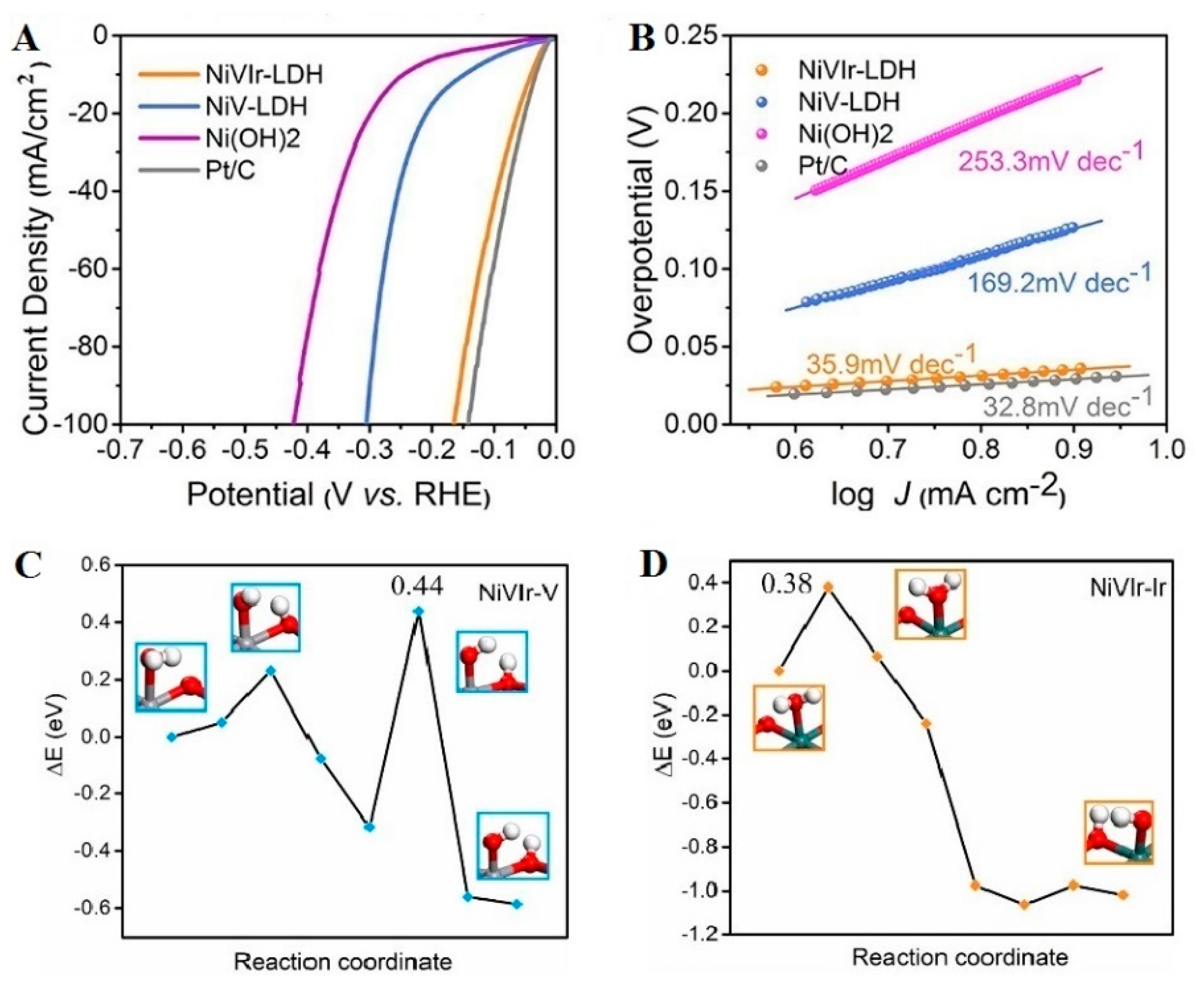

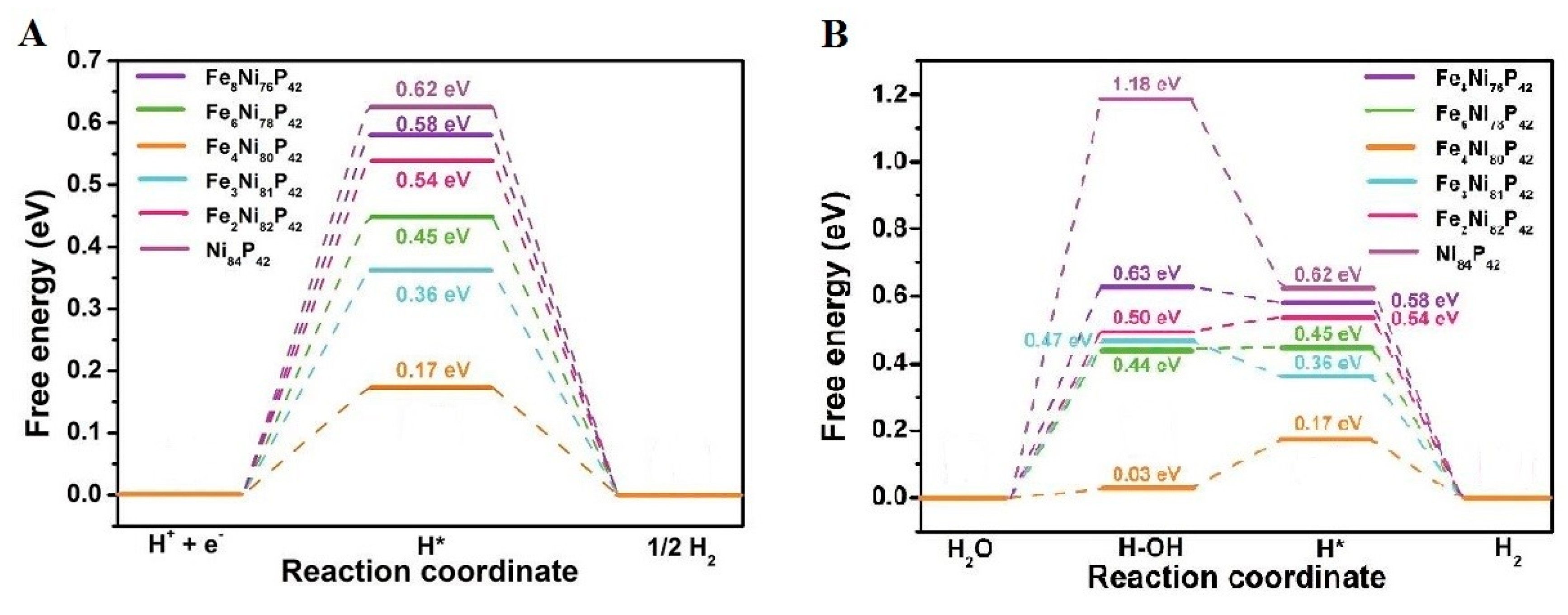

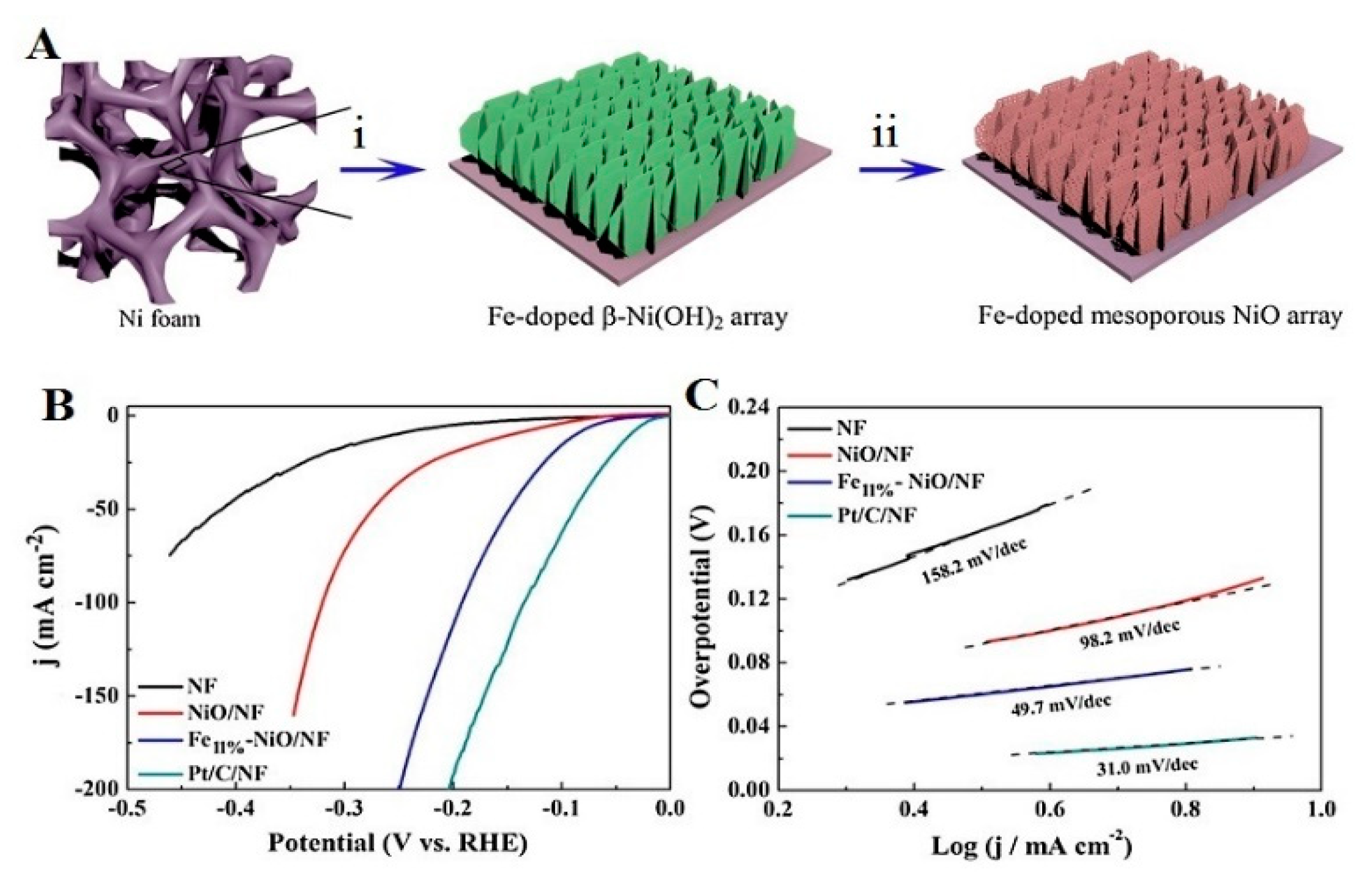

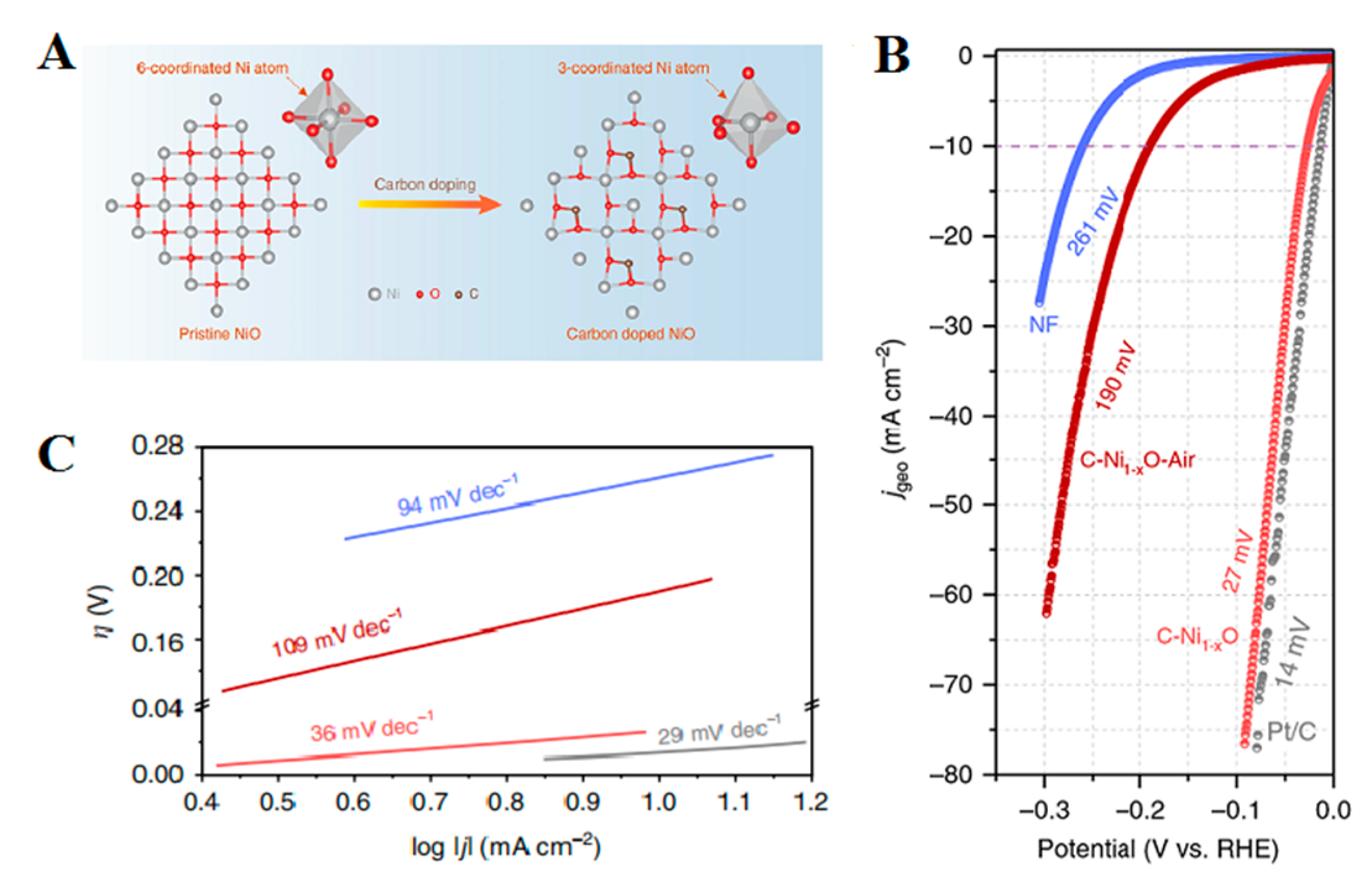
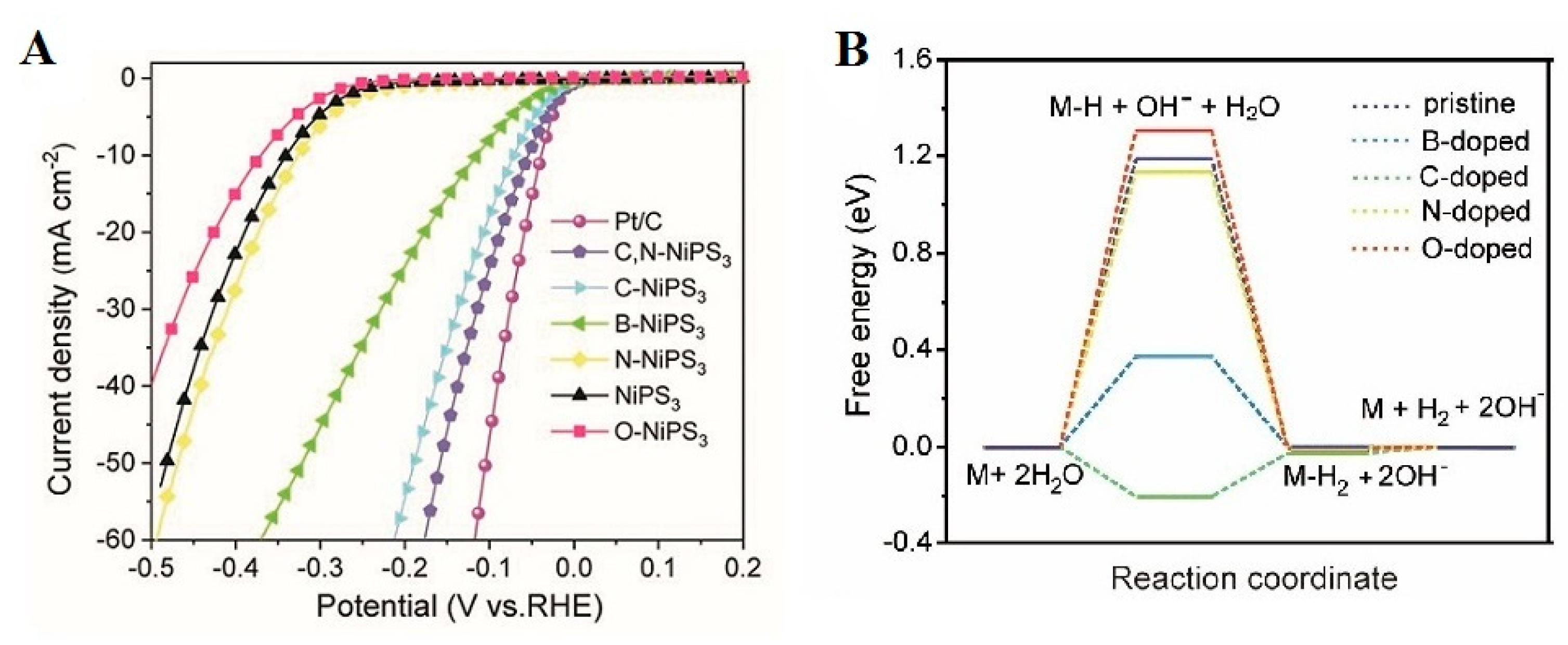
| Catalyst | Electrolyte | Overpotential (mV) η10 | Tafel Slope (mV/dec) | Ref. |
|---|---|---|---|---|
| Ru doped Ni(OH)2/TM-0.2 1 | 1.0 M KOH | 135 | 63.7 | [40] |
| Ni5P4-Ru | 1.0 M KOH | 54 | 52.0 | [41] |
| Ru-NiCoP/NF 2 | 1.0 M KOH | 44 | 45.4 | [42] |
| Ni0.57V0.29Ir0.14-LDH | 1.0 M KOH | 41 | 35.9 | [22] |
| Ir-doped NiCo LDH | 1.0 M KOH | 21 | 35.0 | [43] |
| Mo-Ni2P | 1.0 M KOH | 81 | 53.4 | [44] |
| (Fe0.048Ni0.952)2P/NF | 1.0 M KOH | 103 | 76.6 | [45] |
| 1.0 M PBS | 90 | 82.7 | ||
| 0.5 M H2SO4 | 81 | 41.6 | ||
| NiCoP/rGO 3 | 0.5 M H2SO4 | 58 | 50.0 | [46] |
| V-Ni2P NSAs/CC 4,5 | 1.0 M KOH | 85 | 95.0 | [47] |
| Ni0.82Co0.18O@C/NF 6 | 1.0 M KOH | 102 | 139.0 | [48] |
| Fe11%-NiO/NF | 1.0 M KOH | 88 | 49.7 | [49] |
| Ni(Cu)VOx | 1.0 M KOH | 21 | 28 | [50] |
| NiP1.93Se0.07 | 0.5 M H2SO4 | 84 | 41.0 | [20] |
| Ni(S0.61Se0.39)2 | 1.0 M KOH | 62.7 | 62.0 | [51] |
| b-S-Ni3Se4&b-Se-Ni3S2/NF 7 | 1.0 M KOH | 87 | 61.0 | [52] |
| C–Ni1-xO | 1.0 M KOH | 27 | 36.0 | [53] |
| C, N-NiPS3 | 1.0 M KOH | 53.2 | 38.2 | [54] |
© 2020 by the authors. Licensee MDPI, Basel, Switzerland. This article is an open access article distributed under the terms and conditions of the Creative Commons Attribution (CC BY) license (http://creativecommons.org/licenses/by/4.0/).
Share and Cite
Deng, Y.; Lai, W.; Xu, B. A Mini Review on Doped Nickel-Based Electrocatalysts for Hydrogen Evolution Reaction. Energies 2020, 13, 4651. https://doi.org/10.3390/en13184651
Deng Y, Lai W, Xu B. A Mini Review on Doped Nickel-Based Electrocatalysts for Hydrogen Evolution Reaction. Energies. 2020; 13(18):4651. https://doi.org/10.3390/en13184651
Chicago/Turabian StyleDeng, Yilin, Wei Lai, and Bin Xu. 2020. "A Mini Review on Doped Nickel-Based Electrocatalysts for Hydrogen Evolution Reaction" Energies 13, no. 18: 4651. https://doi.org/10.3390/en13184651
APA StyleDeng, Y., Lai, W., & Xu, B. (2020). A Mini Review on Doped Nickel-Based Electrocatalysts for Hydrogen Evolution Reaction. Energies, 13(18), 4651. https://doi.org/10.3390/en13184651






